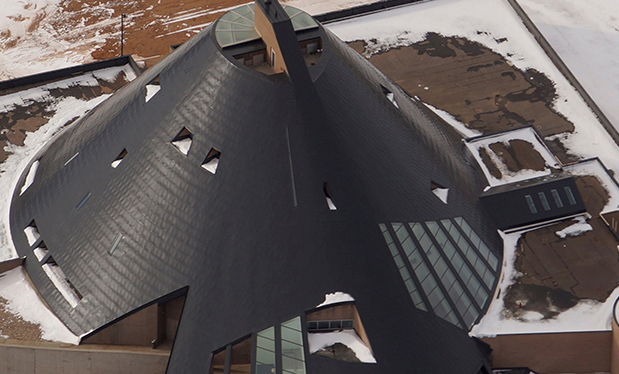When the popularity of rooftops being used as platforms for photovoltaic (PV) systems began to grow, NRCA recognized the need to produce guidelines to assist the construction industry. NRCA was one of the first organizations to publish PV guidelines for rooftop applications. As the PV and roofing industries constantly evolve, NRCA continues to revise its guidelines. In June, NRCA published NRCA Guidelines for Rooftop-mounted Photovoltaic Systems to present the latest information about rooftop-mounted PV systems.
The updated guidelines contain relevant information about rooftop-mounted PV application from the most current editions of model building codes and standards. It also presents NRCA's latest best-practice guidelines for the design and installation of rooftop-mounted PV systems. Information was collected by NRCA from knowledgeable, practicing roofing contractors located throughout the U.S. who are experienced with PV system installations. The guide will be a valuable resource for roofing professionals working with rooftop-mounted PV systems.
History of the guide
NRCA published its first guidelines applicable to rooftop-mounted PV systems in 2009 as Guidelines for Roof-mounted Photovoltaic System Installations. In 2012, NRCA updated the guidelines and renamed the publication NRCA Guidelines for Roof Systems With Rooftop Photovoltaic Components. The 2012 publication contained updated technical information and incorporated some of the suggested changes from feedback NRCA received. It also included code compliance information applicable to roof-mounted PV components based on NFPA (National Fire Protection Association) 70:® National Electrical Code® (NEC®), 2011 Edition; 2012 International Building Code® (IBC); 2012 International Fire Code® (IFC); and NFPA 1: Fire Code, 2012 Edition.
The latest edition was renamed NRCA Guidelines for Rooftop-mounted Photovoltaic Systems and includes updated code compliance information applicable to rooftop-mounted PV systems based on NFPA 70: NEC, 2014 edition; 2015 IBC; 2015 International Residential Code (IRC); 2015 IFC; and NFPA 1: Fire Code, 2015 Edition. The guide was amended to reflect feedback NRCA received from members.
What's inside the guide?
The guide is composed of three chapters and four appendixes. Following is a brief summary of each section.
Chapter 1—Fundamentals covers the basics of a PV system, including terminology and descriptions of the main components that comprise a PV system. This chapter also addresses considerations that building owners, designers and installers should take into account when selecting a roofing contractor.
Chapter 2—Standards and Codes provides a brief overview of standards and model building codes that apply to rooftop-mounted PV systems. This chapter discusses PV-related standards from several organizations, including Underwriters Laboratories (UL) Inc., Institute of Electrical and Electronic Engineers, ASTM International and Factory Mutual (FM) Global.
Code compliance for rooftop-mounted PV systems is somewhat more complicated than it is for other roof systems. For rooftop-mounted PV systems, applicable code requirements are not all provided in a specific code chapter or single code. Instead, they are scattered in multiple chapters of multiple codes. Chapter 2 assembles the PV-related requirements and provides excerpts of pertinent code language from IBC, IRC, IFC, NEC and NFPA 1.
Additionally, figures illustrating rooftop access; pathways; and PV array spacing requirements from IRC, IFC and NFPA 1 accompany the text. The graphic representation of the code language will help roofing professionals visualize the requirements.
Chapter 3—Rooftop-mounted PV System Applications provides roofing-specific information and NRCA recommendations applicable to rooftop-mounted PV system installations. There are steep- and low-slope roof system guidelines for PV attachment and flashings. This chapter also includes figures depicting NRCA's flashing recommendations.
The appendixes provide brief summaries of Roof Integrated Solar Energy™ Inc. and the Certified Solar Roofing Professional™ program, a list of referenced organizations and unit conversion factors.
Note NRCA's guidelines may be more conservative than practices employed by some designers, manufacturers and installers. In many instances, it is the roofing contractors who are responsible for providing long-term roof system solutions.
Differences in fire-resistance testing
As previously mentioned, the guide was brought up-to-date by referencing the latest editions of standards and codes applicable to PV systems. One change worth mentioning was an update to UL 1703, "Standard for Flat-Plate Photovoltaic Modules and Panels," the basis for UL's evaluation of the safety of PV modules and panels.
The previous edition of UL 1703 referenced UL 790, "Standard Test Methods for Fire Tests of Roof Coverings," for determining a panel's fire classification; UL 790 is the test method used to determine roof assemblies' Class A, B and C fire classifications.
In research programs sponsored by the Solar America Board for Codes and Standards and funded by the Department of Energy, UL conducted numerous fire tests of rooftop rack-mounted PV installation configurations (assemblies consisting of a PV panel [or module] and a roof system). The tests revealed a rooftop rack-mounted PV configuration's fire performance is noticeably different from classifications for individual PV panels and roof assemblies. For background information about UL's PV fire testing, see "Revising PV testing," May 2013 issue, page 12.
In light of the research findings, UL 1703 was updated in 2013 and the external fire-resistance testing provisions were revised significantly. UL 1703 now includes its own fire test procedures instead of referencing UL 790. Roof assemblies, PV racking methods and PV panels are tested as combined assemblies with low-slope assemblies being tested separately from steep-slope assemblies. The assemblies are subjected to two test methods—spread-of-flame and burning brand.
UL's effective date for using the new version of UL 1703 is Oct. 25, 2016. Until that date, PV panels are permitted to be classified using UL 1703's previous fire test methods for testing PV panels and roof assemblies individually.
If a project necessitates compliance with FM Global guidelines, the organization has a standard for rigid PV modules: FM 4478, "Approval for Rigid Photovoltaic Modules." FM 4478 provides requirements for rigid PV modules used in an FM-approved roof assembly. The standard provides design requirements and evaluates rigid PV modules for their performances relating to fire, wind uplift and susceptibility to hail damage.
FM 4478 requires PV modules to be tested for their external fire resistances using ASTM E108, "Standard Test Methods for Fire Tests of Roof Coverings." This standard is comparable to UL 790 but not to the fire testing conducted in UL 1703. Accordingly, PV modules are evaluated and labeled as Class A, Class B or Class C. It is important to recognize fire-resistance class according to FM 4478 will not correlate with UL 1703 because the testing methods are different.
A side note
NRCA Guidelines for Rooftop-mounted Photovoltaic Systems includes a reference to NEC because NEC addresses the electrical requirements for PV systems and installations. However, the guide does not contain a detailed explanation about the specific requirements because roofing contractors typically are not involved with the wiring and connections of PV systems. Instead, a roofing contractor's primary responsibility would concern flashing these components to the roof system. However, a roofing contractor should at least be familiar with the general requirements for the electrical equipment.
One important change to NEC 2014 is the addition of arc-fault circuit protection. Because of fire hazard safety concerns, NEC introduced a new requirement to include arc-fault circuit protection for PV systems with direct current (dc) circuits and wiring.
In Article 690.11, Arc-Fault Circuit Protection (direct current), NEC requires a PV system with dc circuits, dc output circuits or both operating at a maximum voltage of 80 volts or greater to be protected by a listed arc-fault interrupter, PV type or other system component listed to provide equal protection. An arc-fault interrupter provides supplementary protection against fires that may arise as a result of arcing faults in a PV system's wiring or components. Arc-fault interrupters typically are integrated with the inverter component of a PV system.
The applicable standard for arc-fault interrupters is UL 1699B, "Photovoltaic (PV) Arc-Fault Circuit Protection." UL 1699B addresses requirements for dc photovoltaic arc-fault circuit protection devices intended for use in solar photovoltaic electrical energy systems as described in NEC. UL 1699B is to be used with UL 1699, "Arc Fault Circuit-Interrupters."
What are you waiting for?
NRCA Guidelines for Rooftop-mounted Photovoltaic Systems represents a unique publication in the industry because it addresses rooftop-mounted PV installations from a roofing contractor's perspective. If you are involved with rooftop-mounted PV systems, I encourage you to get a copy. Free electronic versions of the guide are available to NRCA members via NRCA's bookstore, shop.nrca.net, or the NRCA app, which is available from the Apple App Store, Windows Store or Google Play. Hard copies also are available for purchase.
Joan P. Crowe is an NRCA director of technical services.



